
What Is Normal Looking Skin?
Skin is made up of two major layers: the epidermis and the dermis. The top layer; the epidermis, is made up of multiple layers of flat epidermal cells (keratinized stratified squamous epithelium). Microscopically, the deepest layer consists of rapidly dividing cuboidal cells. Melanocytes (pigment cells) are distributed haphazardly between cuboidal cells. Cells become flat as they move towards the surface and the outermost cells are keratinized dead skin cells. The epidermis is perforated by various glands and hair follicles, the roots of which lie in the dermis. The dermis is made up of collagen and elastin fibers, fibroblasts, and tissue macrophages embedded in the extra cellular matrix. It contains the nerves, blood vessels and lymph vessels as well. Embedded in the dermis are the roots of hair follicles and skin glands. Normal healthy skin is smooth, pigmented according to race, and well hydrated with healthy appendages (nails, hair etc).
- Important notification about information and brand names used in this slideshow!
- Photo courtesy of estrellas spa01 by Picasa : picasaweb.google.com/lh/photo/rSdpRzdeDlQC78ruexh1YA
- Lecture notes on dermatology by Tony Burns and Robin Graham-Brown
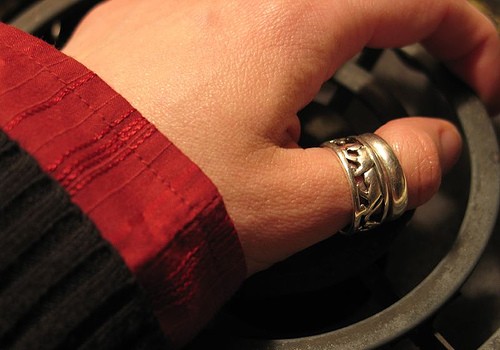
Dry And Cold Skin
Excessive hot weather, cold winds, steamy showers, soaps, irritants, age and various medical conditions dry up the skin. Hot weather and cold winds reduce the water content of the skin. Low water content destabilizes the extra cellular matrix proteins and loosens up the connections between skin cells. Skin becomes flaky. Excessive hot showers and certain types of soap remove the protective oily secretions of the skin, increasing water loss. Irritants can reduce the epidermal and dermal water content as well as directly damage skin cells. Skin conditions like psoriasis are characterized by patches of dry flaky skin especially on extensor surfaces. Hypothyroidism causes a dry, mottled skin with low turgor and elasticity. Ichthyosis causes dry skin that looks like fish scales.
- Important notification about information and brand names used in this slideshow!
- Photo courtesy of le-champignon by Flickr : www.flickr.com/photos/le-champignon/133878972/
- Lecture notes on dermatology by Tony Burns and Robin Graham-Brown
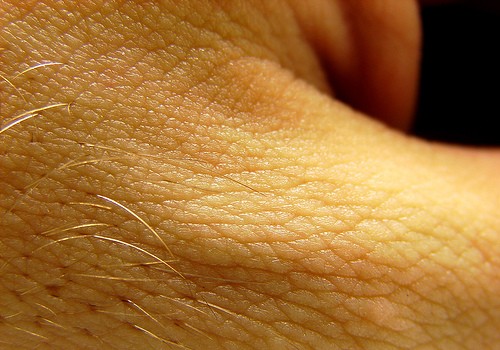
Yellow Or Orange Skin
Excessive intake of carotenoids can give the skin an orange tint. Excessive serum bilirubin content also causes yellowish discoloration of the eyes and mucus membranes (jaundice). Causes of jaundice can be categorized surgically into pre-hepatic, hepatic and post-hepatic causes. Pre-hepatic causes of jaundice are due to excessive breakdown of red blood cells. The serum unconjugated bilirubin content is elevated in pre-hepatic jaundice. Hepatic causes include hepatitis, cirrhosis, and genetic causes like Willson’s disease and Gilbert’s syndrome. Post hepatic causes are due to obstruction of bile ducts. In both hepatic and post-hepatic jaundice, serum conjugated bilirubin content is elevated. Drugs like mepacrine and carotene can cause a yellowish skin discoloration.
- Important notification about information and brand names used in this slideshow!
- Photo courtesy of Matt Reinbold by Flickr : www.flickr.com/photos/furryscalyman/772243754/
- Lecture notes on dermatology by Tony Burns and Robin Graham-Brown
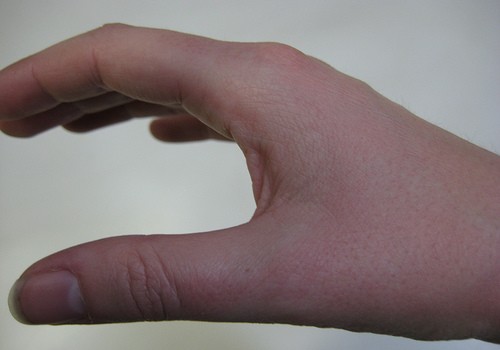
Rash
There are hundreds of causes of skin rashes. Allergies and atopic diseases are the most common causes of skin rashes. Allergies give rise to redness, swelling, vesicles and exudation. In the case of chronic allergies, the skin becomes thick and skin marking becomes prominent (lichenification). Fluid filled blisters (bullae) can be caused by cold, heat, friction, impetigo, chicken pox, herpes zoster, herpes simplex, small pox, or hand foot and mouth disease. Other causes are tinea pedis, insect bites, pemphigus, dermatitis herpetiformis, lichen planus, vasculitis, barbiturates, nalidixic acid, sulfonamides and frusemide. Drug reactions include erythema multiforme, eczema and exfoliative dermatitis.
- Important notification about information and brand names used in this slideshow!
- Photo courtesy of Arthaey Angosii by Flickr : www.flickr.com/photos/arthaey/2145051891/
- Lecture notes on dermatology by Tony Burns and Robin Graham-Brown
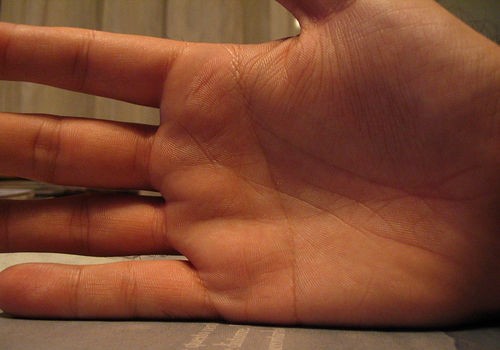
Dark Red Lines On The Palms
Dark lines on the palms are due to hyper-pigmentation. Addison’s disease is a primary adrenocortical insufficiency resulting in excessive secretion of ACTH from the anterior pituitary. ACTH increases skin pigmentation and the darkening is most prominent in the palm creases, scars and gums. Beta carotene also causes an orange/reddish discoloration most prominent on the palms and soles. Chronic kidney failure may give rise to a reddish brown discoloration of the skin. Hereditary hemochromatosis causes a dark reddish brown discoloration due to deposition of iron. Pregnancy, chronic myeloid leukemia, cirrhosis of the liver, polycythemia vera, shoulder hand syndrome and hepatitis can cause a reddish hue on the palms.
- Important notification about information and brand names used in this slideshow!
- Photo courtesy of Sim Dawdler by Flickr : www.flickr.com/photos/simulation/1442156/
- Lecture notes on dermatology by Tony Burns and Robin Graham-Brown
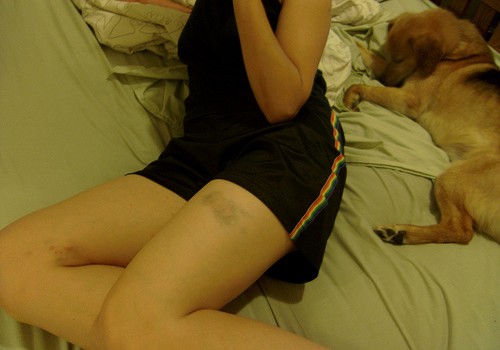
Bruises
Any blunt force trauma can cause a bruise, but spontaneous or easy bruising may be due to some underlying pathology. Bruising is caused by a bleeding under the skin. When a capillary is damaged, platelets plug the defect and clotting factors form a definitive clot to stop bleeding. Disorders like hemophilia, von Willebrand’s disease, thrombocytopenia, thrombasthenia, can disrupt this process. The same is true for non-steroid anti-inflammatory drugs. Connective tissue disorders like Marfan’s disease weaken the capillaries and cause spontaneous bleeding. Cushing’s syndrome is caused by excessive secretion of cortisol. This disrupts the collagen maturation weakening the skin and capillaries. Abdominal streaking and spot hemorrhages are common in Cushing’s syndrome patients.
- Important notification about information and brand names used in this slideshow!
- Photo courtesy of Thirteen Of Clubs by Flickr : www.flickr.com/photos/thirteenofclubs/2610096635/
- Lecture notes on dermatology by Tony Burns and Robin Graham-Brown

Tingling, Pins And Needles
Short-lasting sensations of tingling (paresthesia) may be due to panic, anxiety and hyperventilation. Hyperventilation reduces the serum ionized calcium levels which causes the tingling sensation. Similarly if the parathyroid glands are damaged during thyroidectomy a tingling sensation around the mouth heralds the onset on hypocalcemia. Chronic tingling sensations are commonly caused by poor blood supply, especially in older individuals. Atherosclerosis and peripheral vascular disease are known causes of reduced perfusion. Metabolic disorders like vitamin B deficiency, diabetes and mercury poisoning cause paresthesia. Conditions that compress nerves such as cervical spondylosis, a slipped disk, carpal tunnel syndrome, and maralgia paresthetica present as a tingling sensation along the distribution of the affected nerve.
- Important notification about information and brand names used in this slideshow!
- Photo courtesy of Keturah Stickann by Flickr : www.flickr.com/photos/johnandketurah/3255396640/
- Lecture notes on dermatology by Tony Burns and Robin Graham-Brown

Pale Skin
Localized hypopigmentation and generalized hypopigmentation have different origins. Albinism is an inherited disorder where melanin production is impaired, resulting in pale skin, brownish hair and red irises. A prolonged lack of sunlight gives a pale hue to the skin. Localized pigmentary changes are much more common than generalized hypopigmentation. Autosomal dominant tuberous sclerosis is characterized by small hypopigmented patches. Leprosy causes areas of hypopigmentation with reduced sensation. Pityriasis alba and pityriasis versicolor are common infective causes of hypopigmentation. Pigmentary changes can occur after acute inflammation if enough melanocytes were damaged.
- Important notification about information and brand names used in this slideshow!
- Photo courtesy of Eddy Van 3000 by Flickr : www.flickr.com/photos/e3000/6234971041/
- Lecture notes on dermatology by Tony Burns and Robin Graham-Brown
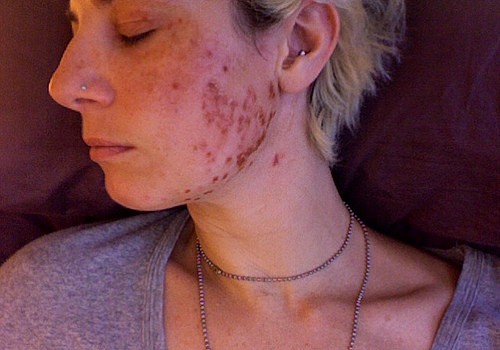
Brown Patches
Café au lait spots are due to neurofibromatosis, an autosomal dominant inherited disorder characterized by the formation of multiple neurofibromas along the course of cutaneous nerves. With age, melanocytes (pigment cells of skin) enlarge and become clustered together, forming dark brownish patches (liver spots/ age spots). Bleeding under the skin followed by alteration of the extravasated blood gives rise to brownish discoloration. Thus, any condition leading to spontaneous subcutaneous bleeding cause brownish patches. Various skin malignancies can manifest as brownish patches on skin. Acanthosis nigricans (dark brown patches near skin folds), diabetic dermopathy and skin necrosis are the result of uncontrolled diabetes.
- Important notification about information and brand names used in this slideshow!
- Photo courtesy of alysha naples by Flickr : www.flickr.com/photos/bluegreen/3703918212/
- Lecture notes on dermatology by Tony Burns and Robin Graham-Brown
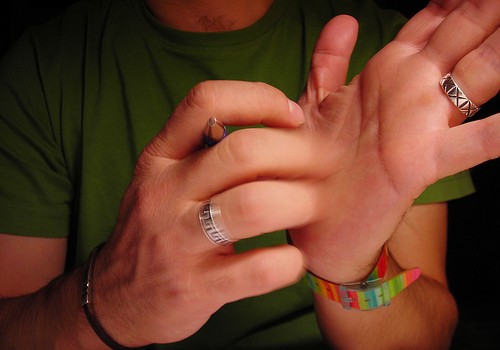
Itching Without Cause
Itchiness without any obvious cause is usually seen in older individuals. Skin may be dry and flaky. A few scratch marks may be seen. Iron deficiency caused by blood loss or poor dietary intake is a known cause of generalized pruritus. Excessive production of red blood cells or polycythemia rubra vera is characterized by an itch triggered by bathing. An obstruction of the bile ducts outside the liver, primary biliary cirrhosis, hepatitis, estrogen and phenothiazine result in excessive serum bilirubin content. It leads to bile slat deposition on the nerves, resulting in nerve irritation. Chronic renal failure is associated with an accumulation of toxic compounds leading to nerve irritation. Excessive secretion of thyroxin (thyrotoxicosis), myxedema, lymphoma, leukemia, skin cancers and drugs like opiates can cause generalized itching.
- Important notification about information and brand names used in this slideshow!
- Photo courtesy of sergis blog by Flickr : www.flickr.com/photos/srgblog/3951790966/
- Lecture notes on dermatology by Tony Burns and Robin Graham-Brown




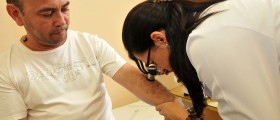
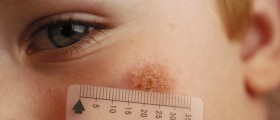





_f_280x120.jpg)

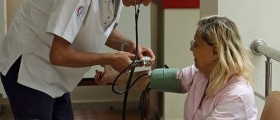




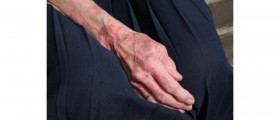
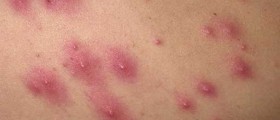

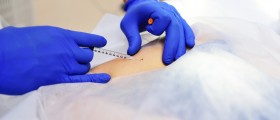





Your thoughts on this
Loading...